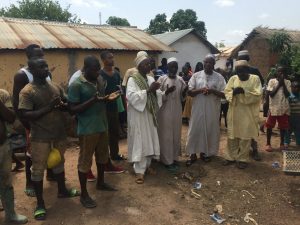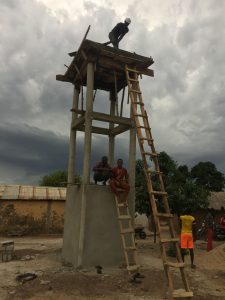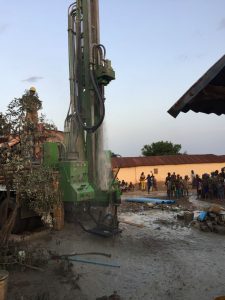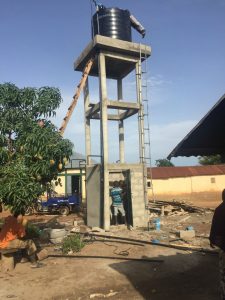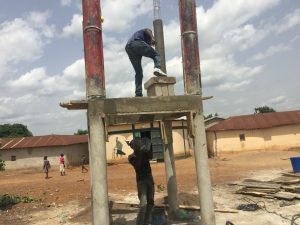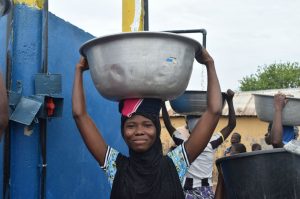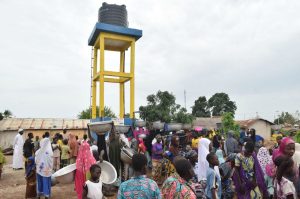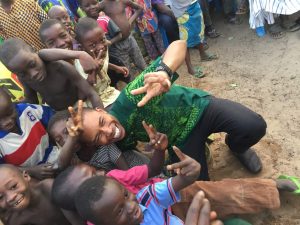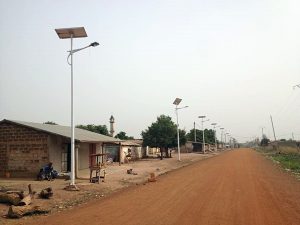 This project is made possible through the partnership of WATER CHARITY and the NATIONAL PEACE CORPS ASSOCIATION.
This project is made possible through the partnership of WATER CHARITY and the NATIONAL PEACE CORPS ASSOCIATION.
This project has been completed. To read about the conclusion, CLICK HERE.
Location
Dagma, Tchamba District, Central Region, Togo
Community Description
Dagma is a small village in the Central Region of Togo with a population of about 700. Including the outlying communities that share a health center, the population grows to 2,000. The village is completely Muslim. Although the village has a traditional way of life, they are extremely open to enacting behavior change to improve the quality of life.
The village health center, which serves both Dagma and the outlying villages, has a laboratory and maternity ward, along with a dedicated team of community health workers intent on improving health outcomes.
Dagma is home to one primary school and is located close to a secondary school. There are approximately 12 latrines and 15 hand-dug wells in the community.
The main source of water in Dagma is a 20-year-old pump, installed by a German NGO, which is located at the primary school and is often the epicenter of village conflicts.
Problem Addressed
There are two main needs for the village: a safer (better water quality) and more convenient water source, and health and hygiene training. These two needs are linked in the sense of keeping people healthy and free from the need for hospitalization by providing safer (cleaner) water that is not degraded by uncontrolled human and animal waste due to the lack of latrines or wellhead protection.
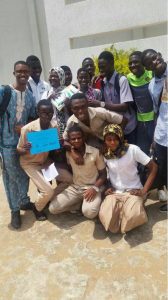 The existing well is in the northern part of the village and has a concrete casing that extends approximately 20 cm above a cement slab. The pump head, about a meter in diameter, is concrete sealed, and a hand pump lifts the water to the ground surface. This pump is used by the village of Dagma and other nearby villages, but only at certain hours of the day during certain times of the year. The restrictions placed on the usage of the pump cause long lines, and makes it extremely difficult to obtain potable water during the dry season, where wells run dry intermittently when overused.
The existing well is in the northern part of the village and has a concrete casing that extends approximately 20 cm above a cement slab. The pump head, about a meter in diameter, is concrete sealed, and a hand pump lifts the water to the ground surface. This pump is used by the village of Dagma and other nearby villages, but only at certain hours of the day during certain times of the year. The restrictions placed on the usage of the pump cause long lines, and makes it extremely difficult to obtain potable water during the dry season, where wells run dry intermittently when overused.
Villagers who can’t use the pump are required to obtain water from one of the fifteen personal hand-dug shallow wells in the village. The yield and water quality of all the wells in Dagma are seasonally variable. Some of the wells are muddy year-round, and some of the wells dry up for part of the year.
While there are approximately 10 personal latrines and two public latrines in Dagma, most of the households do not have latrines, thus resulting in the common practice of defecating wherever one chooses, increasing the spread of uncontrolled human waste.
Access to clean water is essential for a healthy population which in turn results in an improved standard of living. The community understands that without access to clean water, many aspects of their lives are changed, such as absences from school, work-time, and everyday activities, due to illness, which is why the water committee was formed.
Project Description
This project is to provide potable water through the installation of a deep borehole well, a sealed electric pump, a water tower and tank, a filtration system, and 4 spigots for access.
An area around the well will be protected, known as a Wellhead Protection Zone, the hydro-logically sensitive area near the well. Typically for a borehole well, the groundwater flow paths leading to the well are delineated and the land surface area above this zone is cordoned off to prevent contamination of the groundwater through the infiltration of surface-derived contaminants.
After the collection of the materials (sand, gravel, and water), the drilling technician will begin the installation and construction of the well. The initial drilling has been planned to a depth of 60 meters with an additional provision to drill up to 120 meters if necessary, which is specified in the contract signed by the drilling company.
Following the installation of the submerged electric water pump, construction will begin on a 7-meter-high water tower that will support a new polyethylene tank water tank holding 3,000 liters, distributing water by gravity feed to four water spigots at the base of the tower for public use.
The well will be equipped with both a filtering and chlorine-based treatment system so that the water coming from is clear and potable. The work will begin in April 2018 and will take approximately 3 weeks to complete.
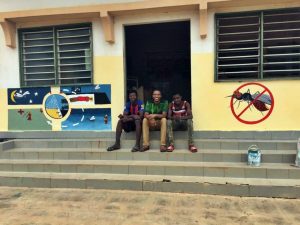 The members of the Dagma water committee had a week-long training conducted by the the well technician, and the government hydro-geologist, on WASH behaviors, well maintenance, and the roles and responsibilities of the committee. The trained members of the committee will assist in doing the “Hygiene and Sanitation Series”. This series will be held in every neighborhood of the village as well as different mosques every Friday for four weeks, leading to the implementation of the borehole well and water tower. The focus of the community sessions will be to discuss the importance of having access to clean, safe drinking water and how to prevent the transmission of communicable diseases through improved hygiene and sanitation practices.
The members of the Dagma water committee had a week-long training conducted by the the well technician, and the government hydro-geologist, on WASH behaviors, well maintenance, and the roles and responsibilities of the committee. The trained members of the committee will assist in doing the “Hygiene and Sanitation Series”. This series will be held in every neighborhood of the village as well as different mosques every Friday for four weeks, leading to the implementation of the borehole well and water tower. The focus of the community sessions will be to discuss the importance of having access to clean, safe drinking water and how to prevent the transmission of communicable diseases through improved hygiene and sanitation practices.
Project Impact
2,000 people will benefit from the project.
Peace Corps Volunteer Directing Project
Kyree Rollins
Monitoring and Maintenance
The water committee is a key component to the sustainability of this project, with each member having specific roles and responsibilities that outline their work during and after pump installation. One of the main roles of the water committee is to monitor the pump’s function and attend to repairs. Technical training will be given to those responsible for repairs, by the borehole well technician and the government hydrogeologist, as well as contact information for nearby experts who will be better equipped to handle more difficult technical issues.
With the assistance of the Dagma water committee, the village of Dagma has already raised 100,000 cfa for future pump repairs but will collect 50 cfa from each community member every 2 months to ensure the sustained maintenance of the pump. The committee will also conduct home visits, surveying the village every 6 months for two years following the installation of the pump. These surveys cover a variety of topics from the efficiency of the water committee in the village to the health of the family.
The PCV will work with the community health workers of the Dagma clinic to evaluate the behaviors and practices of the village using our WASH surveys. At the end of each survey, the community health worker will assess the behaviors of the respondent and give an informal presentation based on the assessment.
The drilling technician, who is from the village, has given a year warranty, agreeing that he will come to repair any problems with the pump for the first year.
Project Funding
Although the funds to get this project underway have been provided by an anonymous donor, we continue to accept donations so that we will have funds on hand for the next project in Togo. Please use this Donate button, and your donation will be attributed to this project and the Peace Corps Volunteer will be notified.
Funds raised in excess of the project amount will be allocated to other projects in the country.
Conclusion of Dagma Borehole Project – Togo
This project has been completed under the direction of Peace Corps Volunteer Kyree Rollins. To read about the start of the project, CLICK HERE.
The project was designed to provide potable water through the installation of a deep borehole well, a sealed electric pump, a water tower and tank, a filtration system, and spigots for access.
Kyree reports:
Specific Work Done
This project was made up of 3 main components. Firstly, the community health workers (CHWs) of the Dagma health clinic and the PCV conducted home visits, surveying every household in the village to obtain a base-line understanding of the WASH techniques practiced by villagers before the installation of a new water source.Afterwards, a water committee was established to both maintain functioning condition of the well, pump and spigots, and to become focal points in Dagma on basic hygiene, sanitation, and water storage techniques. The committee received a week-long training by the PCV, the well technician, and a hydro-geologist from the Department of Hydraulics on proper WASH practices.
Secondly, the water committee conducted a village wide training on how to ameliorate WASH behaviors and practices. The trainings were held in different neighborhoods of the village, at every mosque, and at the village clinic during the implementation of the project. The main message of these trainings was that even a potable source of water could be contaminated if behaviors remain the same. They used that message to encourage healthy WASH practices, such as proper hand washing, the use of ORS (when needed), proper disposal of fecal matter (animal and human), and water storage/treatment.
Thirdly, a 60-meter borehole well equipped with a filtering system, was installed in the center of Dagma. Afterwards, an electric water pump was submerged, and a 7-meter-high water tower was constructed to hold a 3,000-liter polyethylene water tank. Five spigots were added at the base of the tower, four long spigots along the edges of the base and one smaller in the center.
The Dagma people were extremely motivated to commence this project and even more so to reap the benefits of a long-overdue potable water source. During the construction, many villagers came to watch in excitement, assisted with tasks when needed, and provided food and water to the workers. Roughly one month after the inauguration of the project, the CHWs conducted a second round of house visits to assess the level of behavior change after the use of the new well.
Capacity and Skills Built
This project wasn’t to solely create a potable source of water for the Dagma community, but to also show the community that they can change their own lives by protecting and improving their drinking quality through the sharing of responsibilities, technical expertise, and hygiene and disease prevention practices. Since the beginning of the project, many people have increased their capacity, from the team of apprentices working with the head technician, to the members of the community who assisted with labor for a portion of the community contribution.
Most of the capacity building came from the newly developed water committee, who gained skills in project management and monitoring, project design, as well as pump maintenance. Whether it been through direct or indirect contact, the water committee also played a huge role in increasing the village’s capacity to maintain healthy families and reduce diarrheal diseases. The community health workers gained skills as well, as they worked closely with the PCV to survey the village, building their capacity in technical health, survey development, and survey implementation.
Sustainability
The Dagma water committee will guarantee the sustainability of this project. Each member has clearly identified roles and responsibilities that were created before the installation of the well and will continue until long after its inauguration.Technical training was given to the entire committee for the monitoring of the wells functions and to attend to small repairs. They also received contact information for several nearby experts for serious problems, although, the well technician gave the village a one-year warranty, offering his services for free for a full year if needed. The village has already, now, raised 140,000 cfa for future repairs and plans to collect 50 cfa from each community member using the well. The water committee, the official homologue of the PCV, and the chief of the village will meet bi-monthly for the first year to discuss the funds collected, well maintenance, and the health of the village.
Testimonials from the Community
Mr. GOUFFE Kasimou, Water Committee President
Because of this project both myself and the community has benefited from a lot of things. The training that we participated in equipped us with the tools necessary to convey proper WASH practices to the entire village. What we learned is that with time a lot of things will change in village because of potable water. Adults and kids fall sick due to non-potable water and microbes but with the new well, the water is truly limpid. This project will serve a lot people and they will be in good health. We truly appreciate the work of Kyree and we wish him good luck.Mr. ATCHA Affo Atcha
The entire community is proud of this project. A lot of people pray every day because of the support received by the Peace Corps and Water Charity. Before people used water from their hand-dug wells and had many difficulties, but with this project they have greater access to potable water and it saves time. In my own home we use our hand-dug well for washing but pay to use the borehole well for drinking. I am very thankful for this project and the good it is doing in my village!
We extend our thanks to Kyree for completing this important project.

